Social Determinants of Health: Interventions and Marmot's Review
VerifiedAdded on 2023/06/13
|8
|2267
|70
Essay
AI Summary
This essay delves into the social determinants of health, drawing upon the World Health Organization's definition and Marmot's concept of how factors like income, education, and social connections influence health outcomes. It highlights Marmot's six policy objectives aimed at reducing health inequalities, focusing on creating a fair society with healthy lives. The essay discusses two interventions: smoking cessation services and Sure Start children's centers, assessing their effectiveness in addressing health inequalities. The stop smoking intervention shows promise in reducing smoking rates, particularly in deprived areas, while the Sure Start program aims to provide early support to families but faces challenges in reaching all segments of society due to budget limitations. The essay concludes by emphasizing the importance of addressing social determinants to promote health equity and ensure basic human rights to health and well-being, especially for vulnerable populations.
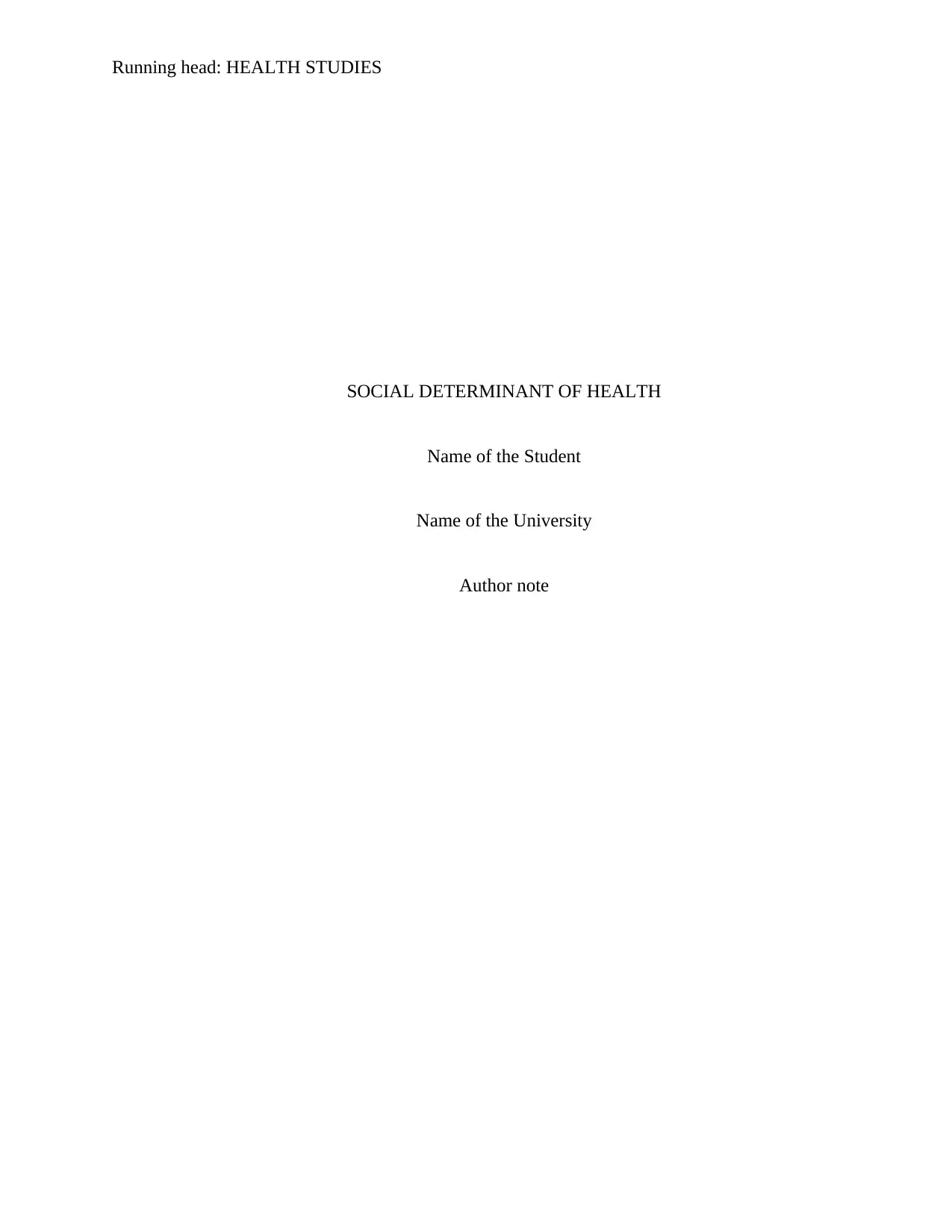
Running head: HEALTH STUDIES
SOCIAL DETERMINANT OF HEALTH
Name of the Student
Name of the University
Author note
SOCIAL DETERMINANT OF HEALTH
Name of the Student
Name of the University
Author note
Paraphrase This Document
Need a fresh take? Get an instant paraphrase of this document with our AI Paraphraser
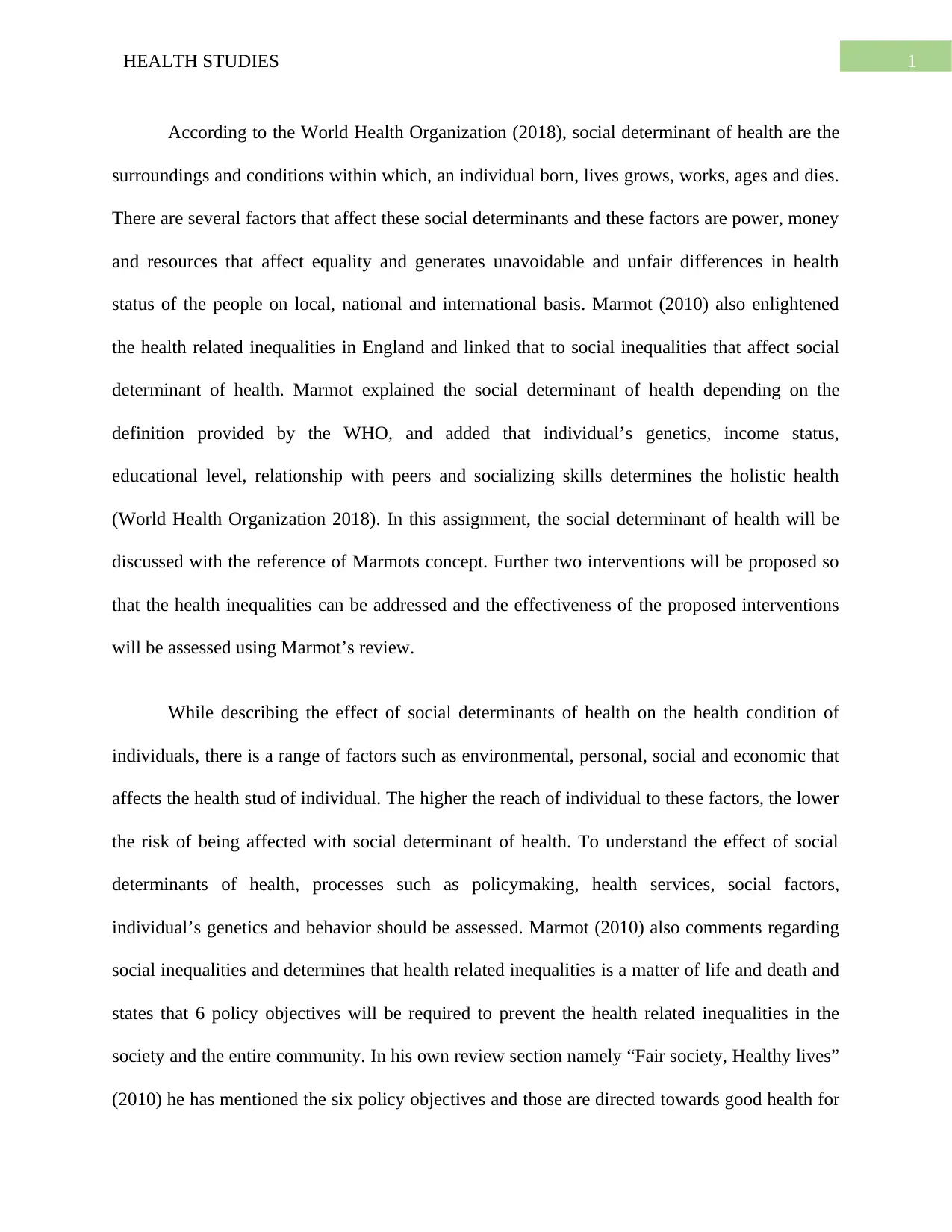
1HEALTH STUDIES
According to the World Health Organization (2018), social determinant of health are the
surroundings and conditions within which, an individual born, lives grows, works, ages and dies.
There are several factors that affect these social determinants and these factors are power, money
and resources that affect equality and generates unavoidable and unfair differences in health
status of the people on local, national and international basis. Marmot (2010) also enlightened
the health related inequalities in England and linked that to social inequalities that affect social
determinant of health. Marmot explained the social determinant of health depending on the
definition provided by the WHO, and added that individual’s genetics, income status,
educational level, relationship with peers and socializing skills determines the holistic health
(World Health Organization 2018). In this assignment, the social determinant of health will be
discussed with the reference of Marmots concept. Further two interventions will be proposed so
that the health inequalities can be addressed and the effectiveness of the proposed interventions
will be assessed using Marmot’s review.
While describing the effect of social determinants of health on the health condition of
individuals, there is a range of factors such as environmental, personal, social and economic that
affects the health stud of individual. The higher the reach of individual to these factors, the lower
the risk of being affected with social determinant of health. To understand the effect of social
determinants of health, processes such as policymaking, health services, social factors,
individual’s genetics and behavior should be assessed. Marmot (2010) also comments regarding
social inequalities and determines that health related inequalities is a matter of life and death and
states that 6 policy objectives will be required to prevent the health related inequalities in the
society and the entire community. In his own review section namely “Fair society, Healthy lives”
(2010) he has mentioned the six policy objectives and those are directed towards good health for
According to the World Health Organization (2018), social determinant of health are the
surroundings and conditions within which, an individual born, lives grows, works, ages and dies.
There are several factors that affect these social determinants and these factors are power, money
and resources that affect equality and generates unavoidable and unfair differences in health
status of the people on local, national and international basis. Marmot (2010) also enlightened
the health related inequalities in England and linked that to social inequalities that affect social
determinant of health. Marmot explained the social determinant of health depending on the
definition provided by the WHO, and added that individual’s genetics, income status,
educational level, relationship with peers and socializing skills determines the holistic health
(World Health Organization 2018). In this assignment, the social determinant of health will be
discussed with the reference of Marmots concept. Further two interventions will be proposed so
that the health inequalities can be addressed and the effectiveness of the proposed interventions
will be assessed using Marmot’s review.
While describing the effect of social determinants of health on the health condition of
individuals, there is a range of factors such as environmental, personal, social and economic that
affects the health stud of individual. The higher the reach of individual to these factors, the lower
the risk of being affected with social determinant of health. To understand the effect of social
determinants of health, processes such as policymaking, health services, social factors,
individual’s genetics and behavior should be assessed. Marmot (2010) also comments regarding
social inequalities and determines that health related inequalities is a matter of life and death and
states that 6 policy objectives will be required to prevent the health related inequalities in the
society and the entire community. In his own review section namely “Fair society, Healthy lives”
(2010) he has mentioned the six policy objectives and those are directed towards good health for
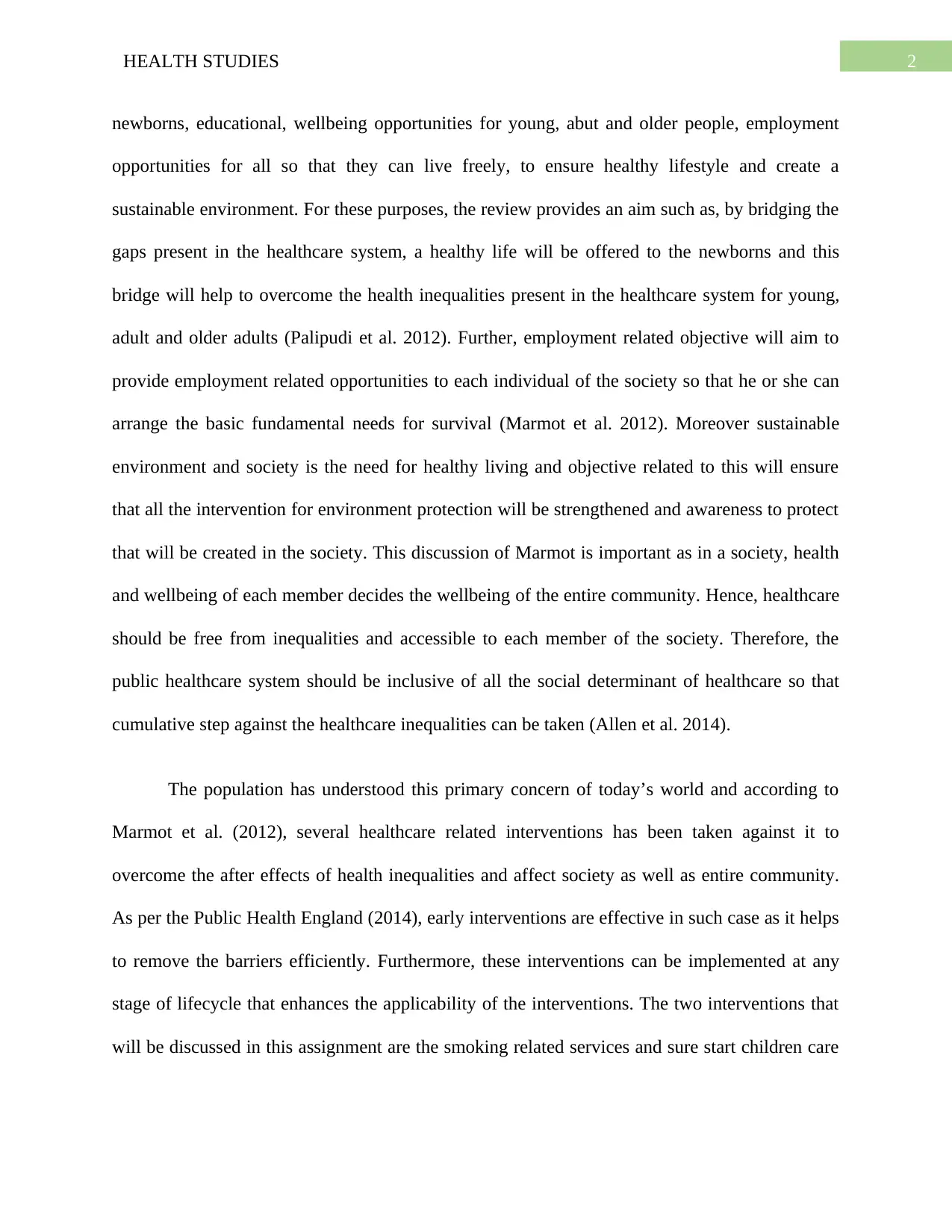
2HEALTH STUDIES
newborns, educational, wellbeing opportunities for young, abut and older people, employment
opportunities for all so that they can live freely, to ensure healthy lifestyle and create a
sustainable environment. For these purposes, the review provides an aim such as, by bridging the
gaps present in the healthcare system, a healthy life will be offered to the newborns and this
bridge will help to overcome the health inequalities present in the healthcare system for young,
adult and older adults (Palipudi et al. 2012). Further, employment related objective will aim to
provide employment related opportunities to each individual of the society so that he or she can
arrange the basic fundamental needs for survival (Marmot et al. 2012). Moreover sustainable
environment and society is the need for healthy living and objective related to this will ensure
that all the intervention for environment protection will be strengthened and awareness to protect
that will be created in the society. This discussion of Marmot is important as in a society, health
and wellbeing of each member decides the wellbeing of the entire community. Hence, healthcare
should be free from inequalities and accessible to each member of the society. Therefore, the
public healthcare system should be inclusive of all the social determinant of healthcare so that
cumulative step against the healthcare inequalities can be taken (Allen et al. 2014).
The population has understood this primary concern of today’s world and according to
Marmot et al. (2012), several healthcare related interventions has been taken against it to
overcome the after effects of health inequalities and affect society as well as entire community.
As per the Public Health England (2014), early interventions are effective in such case as it helps
to remove the barriers efficiently. Furthermore, these interventions can be implemented at any
stage of lifecycle that enhances the applicability of the interventions. The two interventions that
will be discussed in this assignment are the smoking related services and sure start children care
newborns, educational, wellbeing opportunities for young, abut and older people, employment
opportunities for all so that they can live freely, to ensure healthy lifestyle and create a
sustainable environment. For these purposes, the review provides an aim such as, by bridging the
gaps present in the healthcare system, a healthy life will be offered to the newborns and this
bridge will help to overcome the health inequalities present in the healthcare system for young,
adult and older adults (Palipudi et al. 2012). Further, employment related objective will aim to
provide employment related opportunities to each individual of the society so that he or she can
arrange the basic fundamental needs for survival (Marmot et al. 2012). Moreover sustainable
environment and society is the need for healthy living and objective related to this will ensure
that all the intervention for environment protection will be strengthened and awareness to protect
that will be created in the society. This discussion of Marmot is important as in a society, health
and wellbeing of each member decides the wellbeing of the entire community. Hence, healthcare
should be free from inequalities and accessible to each member of the society. Therefore, the
public healthcare system should be inclusive of all the social determinant of healthcare so that
cumulative step against the healthcare inequalities can be taken (Allen et al. 2014).
The population has understood this primary concern of today’s world and according to
Marmot et al. (2012), several healthcare related interventions has been taken against it to
overcome the after effects of health inequalities and affect society as well as entire community.
As per the Public Health England (2014), early interventions are effective in such case as it helps
to remove the barriers efficiently. Furthermore, these interventions can be implemented at any
stage of lifecycle that enhances the applicability of the interventions. The two interventions that
will be discussed in this assignment are the smoking related services and sure start children care
⊘ This is a preview!⊘
Do you want full access?
Subscribe today to unlock all pages.

Trusted by 1+ million students worldwide
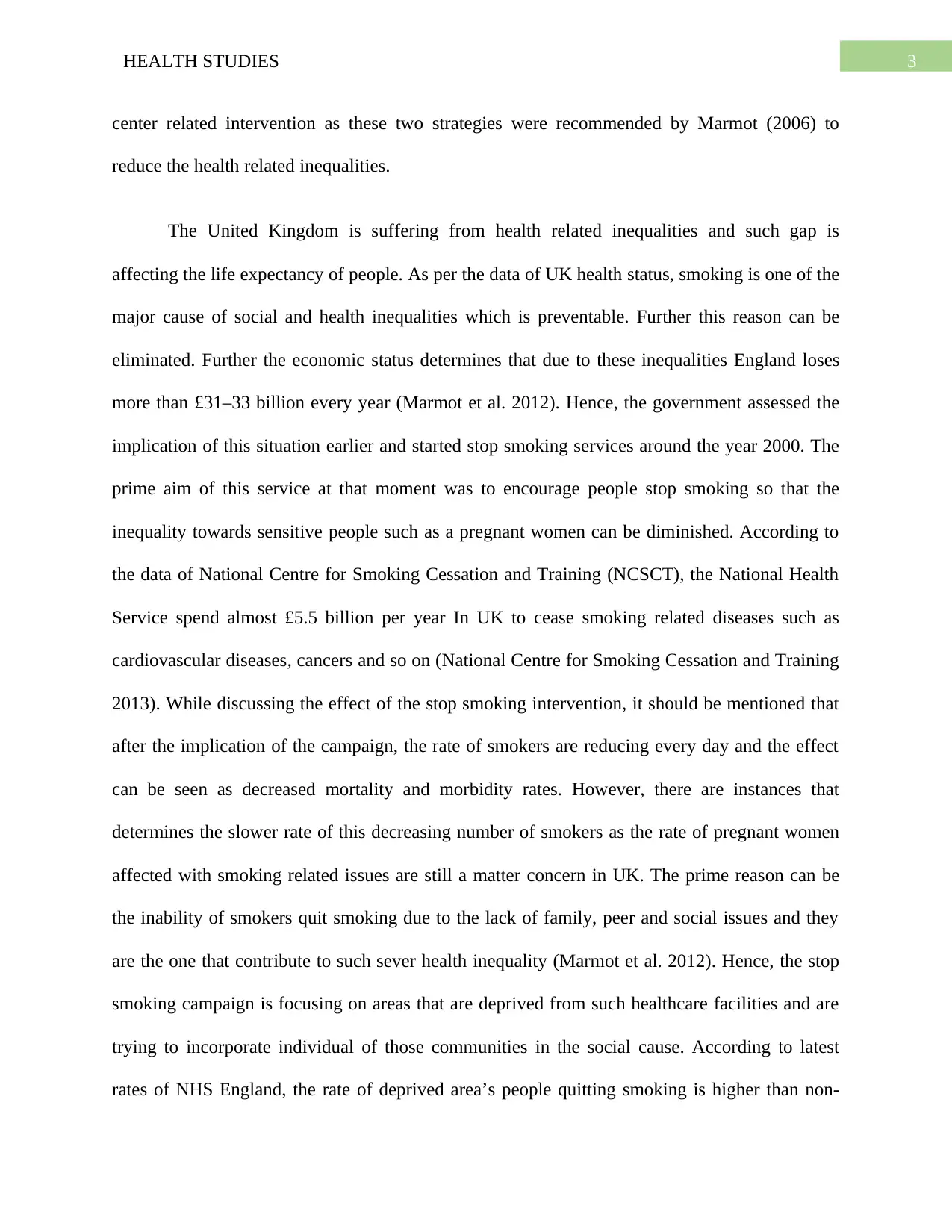
3HEALTH STUDIES
center related intervention as these two strategies were recommended by Marmot (2006) to
reduce the health related inequalities.
The United Kingdom is suffering from health related inequalities and such gap is
affecting the life expectancy of people. As per the data of UK health status, smoking is one of the
major cause of social and health inequalities which is preventable. Further this reason can be
eliminated. Further the economic status determines that due to these inequalities England loses
more than £31–33 billion every year (Marmot et al. 2012). Hence, the government assessed the
implication of this situation earlier and started stop smoking services around the year 2000. The
prime aim of this service at that moment was to encourage people stop smoking so that the
inequality towards sensitive people such as a pregnant women can be diminished. According to
the data of National Centre for Smoking Cessation and Training (NCSCT), the National Health
Service spend almost £5.5 billion per year In UK to cease smoking related diseases such as
cardiovascular diseases, cancers and so on (National Centre for Smoking Cessation and Training
2013). While discussing the effect of the stop smoking intervention, it should be mentioned that
after the implication of the campaign, the rate of smokers are reducing every day and the effect
can be seen as decreased mortality and morbidity rates. However, there are instances that
determines the slower rate of this decreasing number of smokers as the rate of pregnant women
affected with smoking related issues are still a matter concern in UK. The prime reason can be
the inability of smokers quit smoking due to the lack of family, peer and social issues and they
are the one that contribute to such sever health inequality (Marmot et al. 2012). Hence, the stop
smoking campaign is focusing on areas that are deprived from such healthcare facilities and are
trying to incorporate individual of those communities in the social cause. According to latest
rates of NHS England, the rate of deprived area’s people quitting smoking is higher than non-
center related intervention as these two strategies were recommended by Marmot (2006) to
reduce the health related inequalities.
The United Kingdom is suffering from health related inequalities and such gap is
affecting the life expectancy of people. As per the data of UK health status, smoking is one of the
major cause of social and health inequalities which is preventable. Further this reason can be
eliminated. Further the economic status determines that due to these inequalities England loses
more than £31–33 billion every year (Marmot et al. 2012). Hence, the government assessed the
implication of this situation earlier and started stop smoking services around the year 2000. The
prime aim of this service at that moment was to encourage people stop smoking so that the
inequality towards sensitive people such as a pregnant women can be diminished. According to
the data of National Centre for Smoking Cessation and Training (NCSCT), the National Health
Service spend almost £5.5 billion per year In UK to cease smoking related diseases such as
cardiovascular diseases, cancers and so on (National Centre for Smoking Cessation and Training
2013). While discussing the effect of the stop smoking intervention, it should be mentioned that
after the implication of the campaign, the rate of smokers are reducing every day and the effect
can be seen as decreased mortality and morbidity rates. However, there are instances that
determines the slower rate of this decreasing number of smokers as the rate of pregnant women
affected with smoking related issues are still a matter concern in UK. The prime reason can be
the inability of smokers quit smoking due to the lack of family, peer and social issues and they
are the one that contribute to such sever health inequality (Marmot et al. 2012). Hence, the stop
smoking campaign is focusing on areas that are deprived from such healthcare facilities and are
trying to incorporate individual of those communities in the social cause. According to latest
rates of NHS England, the rate of deprived area’s people quitting smoking is higher than non-
Paraphrase This Document
Need a fresh take? Get an instant paraphrase of this document with our AI Paraphraser
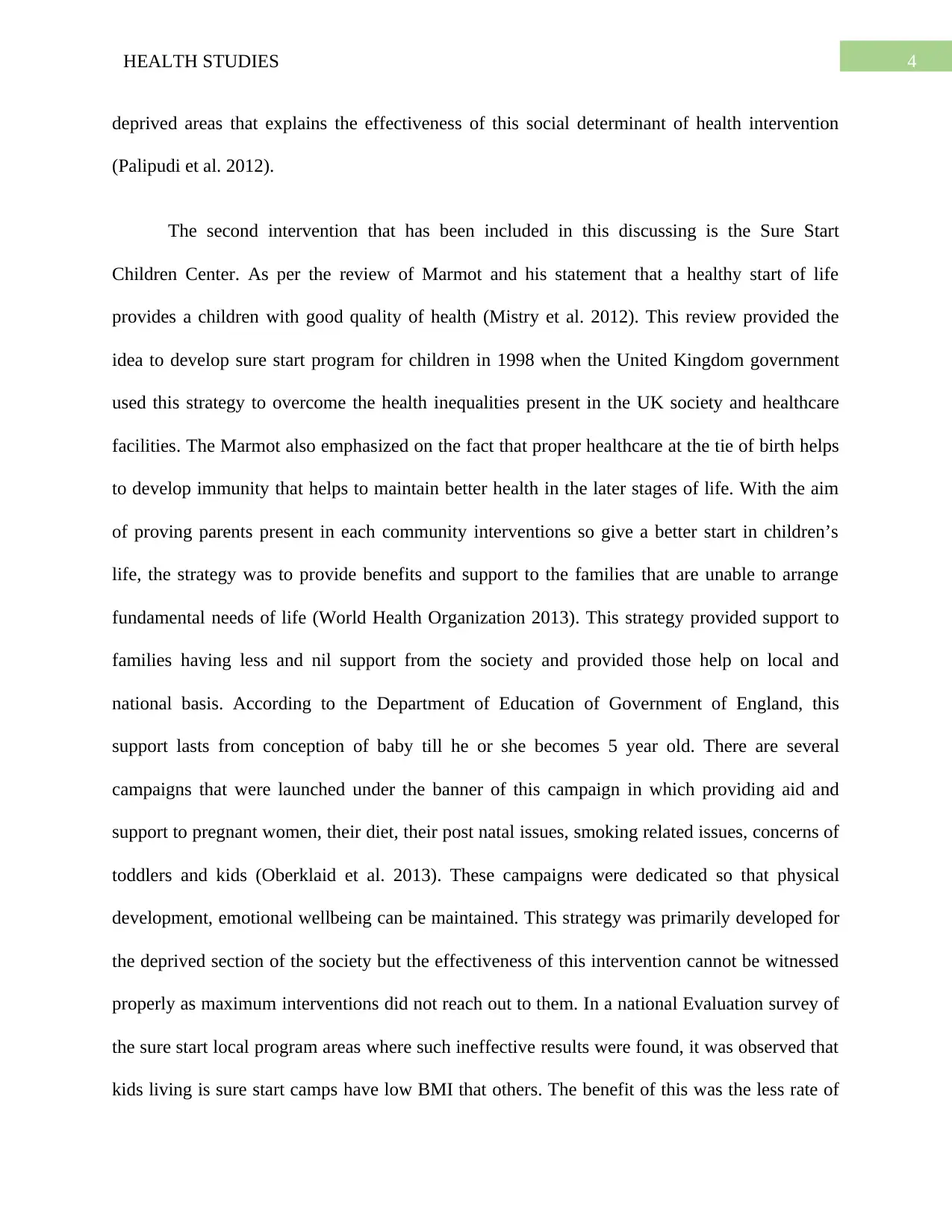
4HEALTH STUDIES
deprived areas that explains the effectiveness of this social determinant of health intervention
(Palipudi et al. 2012).
The second intervention that has been included in this discussing is the Sure Start
Children Center. As per the review of Marmot and his statement that a healthy start of life
provides a children with good quality of health (Mistry et al. 2012). This review provided the
idea to develop sure start program for children in 1998 when the United Kingdom government
used this strategy to overcome the health inequalities present in the UK society and healthcare
facilities. The Marmot also emphasized on the fact that proper healthcare at the tie of birth helps
to develop immunity that helps to maintain better health in the later stages of life. With the aim
of proving parents present in each community interventions so give a better start in children’s
life, the strategy was to provide benefits and support to the families that are unable to arrange
fundamental needs of life (World Health Organization 2013). This strategy provided support to
families having less and nil support from the society and provided those help on local and
national basis. According to the Department of Education of Government of England, this
support lasts from conception of baby till he or she becomes 5 year old. There are several
campaigns that were launched under the banner of this campaign in which providing aid and
support to pregnant women, their diet, their post natal issues, smoking related issues, concerns of
toddlers and kids (Oberklaid et al. 2013). These campaigns were dedicated so that physical
development, emotional wellbeing can be maintained. This strategy was primarily developed for
the deprived section of the society but the effectiveness of this intervention cannot be witnessed
properly as maximum interventions did not reach out to them. In a national Evaluation survey of
the sure start local program areas where such ineffective results were found, it was observed that
kids living is sure start camps have low BMI that others. The benefit of this was the less rate of
deprived areas that explains the effectiveness of this social determinant of health intervention
(Palipudi et al. 2012).
The second intervention that has been included in this discussing is the Sure Start
Children Center. As per the review of Marmot and his statement that a healthy start of life
provides a children with good quality of health (Mistry et al. 2012). This review provided the
idea to develop sure start program for children in 1998 when the United Kingdom government
used this strategy to overcome the health inequalities present in the UK society and healthcare
facilities. The Marmot also emphasized on the fact that proper healthcare at the tie of birth helps
to develop immunity that helps to maintain better health in the later stages of life. With the aim
of proving parents present in each community interventions so give a better start in children’s
life, the strategy was to provide benefits and support to the families that are unable to arrange
fundamental needs of life (World Health Organization 2013). This strategy provided support to
families having less and nil support from the society and provided those help on local and
national basis. According to the Department of Education of Government of England, this
support lasts from conception of baby till he or she becomes 5 year old. There are several
campaigns that were launched under the banner of this campaign in which providing aid and
support to pregnant women, their diet, their post natal issues, smoking related issues, concerns of
toddlers and kids (Oberklaid et al. 2013). These campaigns were dedicated so that physical
development, emotional wellbeing can be maintained. This strategy was primarily developed for
the deprived section of the society but the effectiveness of this intervention cannot be witnessed
properly as maximum interventions did not reach out to them. In a national Evaluation survey of
the sure start local program areas where such ineffective results were found, it was observed that
kids living is sure start camps have low BMI that others. The benefit of this was the less rate of
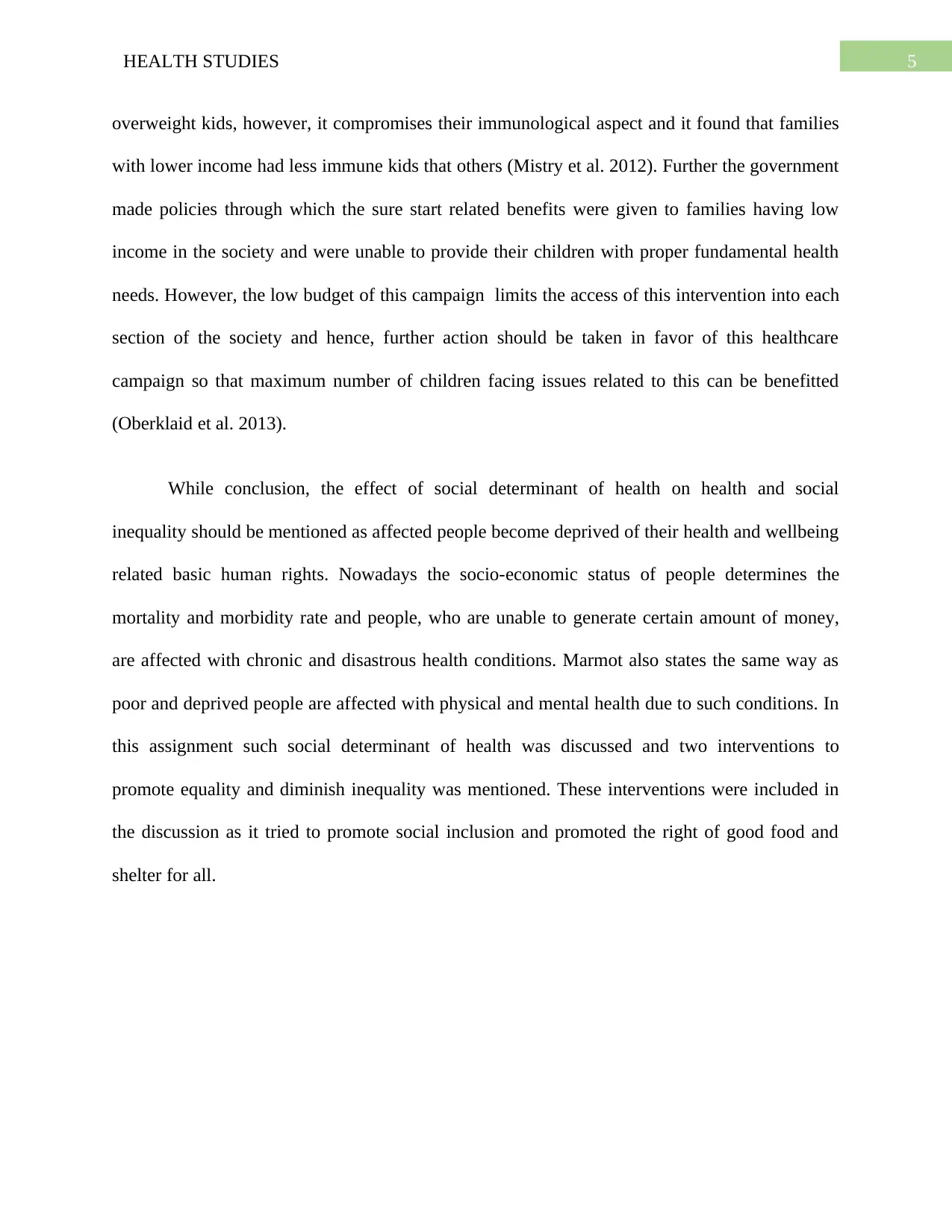
5HEALTH STUDIES
overweight kids, however, it compromises their immunological aspect and it found that families
with lower income had less immune kids that others (Mistry et al. 2012). Further the government
made policies through which the sure start related benefits were given to families having low
income in the society and were unable to provide their children with proper fundamental health
needs. However, the low budget of this campaign limits the access of this intervention into each
section of the society and hence, further action should be taken in favor of this healthcare
campaign so that maximum number of children facing issues related to this can be benefitted
(Oberklaid et al. 2013).
While conclusion, the effect of social determinant of health on health and social
inequality should be mentioned as affected people become deprived of their health and wellbeing
related basic human rights. Nowadays the socio-economic status of people determines the
mortality and morbidity rate and people, who are unable to generate certain amount of money,
are affected with chronic and disastrous health conditions. Marmot also states the same way as
poor and deprived people are affected with physical and mental health due to such conditions. In
this assignment such social determinant of health was discussed and two interventions to
promote equality and diminish inequality was mentioned. These interventions were included in
the discussion as it tried to promote social inclusion and promoted the right of good food and
shelter for all.
overweight kids, however, it compromises their immunological aspect and it found that families
with lower income had less immune kids that others (Mistry et al. 2012). Further the government
made policies through which the sure start related benefits were given to families having low
income in the society and were unable to provide their children with proper fundamental health
needs. However, the low budget of this campaign limits the access of this intervention into each
section of the society and hence, further action should be taken in favor of this healthcare
campaign so that maximum number of children facing issues related to this can be benefitted
(Oberklaid et al. 2013).
While conclusion, the effect of social determinant of health on health and social
inequality should be mentioned as affected people become deprived of their health and wellbeing
related basic human rights. Nowadays the socio-economic status of people determines the
mortality and morbidity rate and people, who are unable to generate certain amount of money,
are affected with chronic and disastrous health conditions. Marmot also states the same way as
poor and deprived people are affected with physical and mental health due to such conditions. In
this assignment such social determinant of health was discussed and two interventions to
promote equality and diminish inequality was mentioned. These interventions were included in
the discussion as it tried to promote social inclusion and promoted the right of good food and
shelter for all.
⊘ This is a preview!⊘
Do you want full access?
Subscribe today to unlock all pages.

Trusted by 1+ million students worldwide
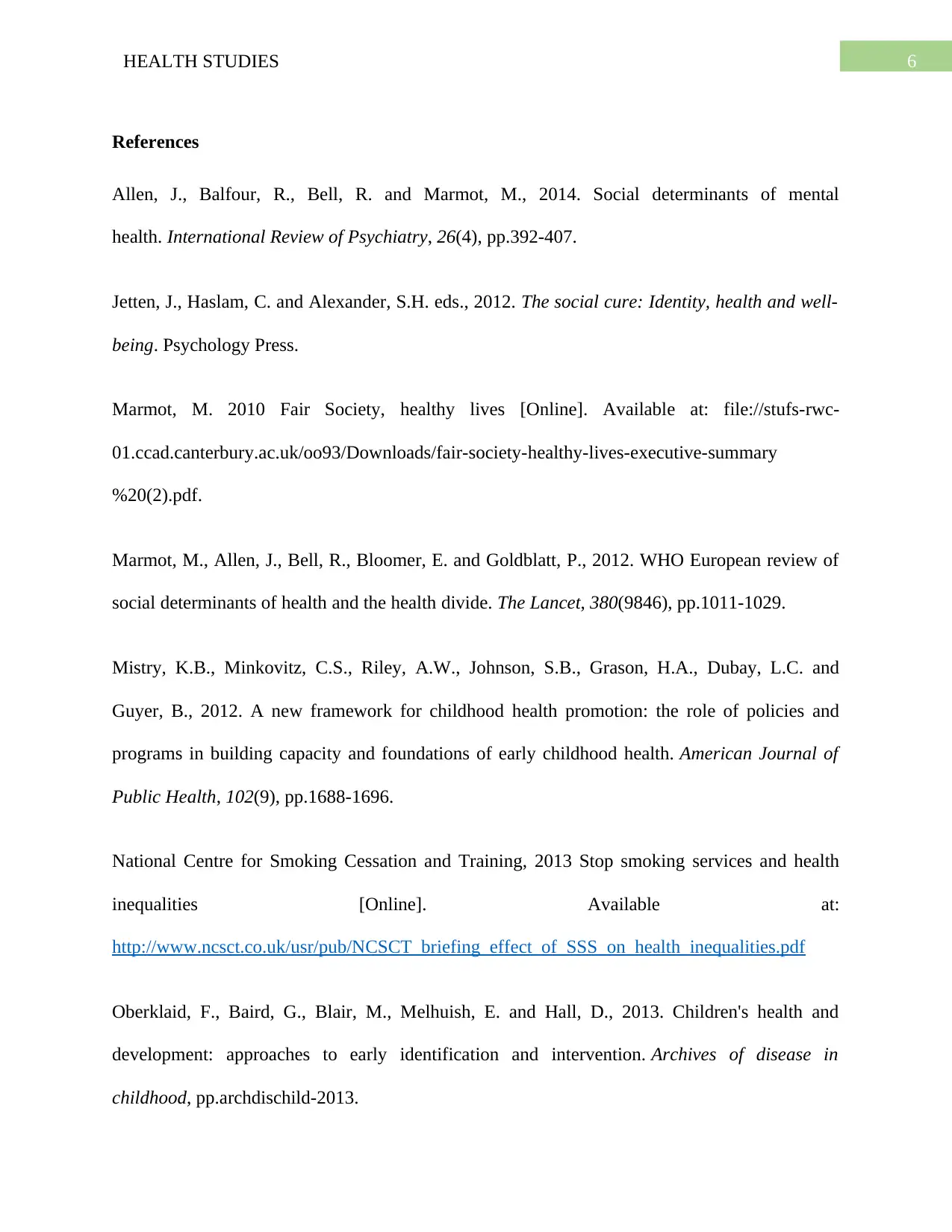
6HEALTH STUDIES
References
Allen, J., Balfour, R., Bell, R. and Marmot, M., 2014. Social determinants of mental
health. International Review of Psychiatry, 26(4), pp.392-407.
Jetten, J., Haslam, C. and Alexander, S.H. eds., 2012. The social cure: Identity, health and well-
being. Psychology Press.
Marmot, M. 2010 Fair Society, healthy lives [Online]. Available at: file://stufs-rwc-
01.ccad.canterbury.ac.uk/oo93/Downloads/fair-society-healthy-lives-executive-summary
%20(2).pdf.
Marmot, M., Allen, J., Bell, R., Bloomer, E. and Goldblatt, P., 2012. WHO European review of
social determinants of health and the health divide. The Lancet, 380(9846), pp.1011-1029.
Mistry, K.B., Minkovitz, C.S., Riley, A.W., Johnson, S.B., Grason, H.A., Dubay, L.C. and
Guyer, B., 2012. A new framework for childhood health promotion: the role of policies and
programs in building capacity and foundations of early childhood health. American Journal of
Public Health, 102(9), pp.1688-1696.
National Centre for Smoking Cessation and Training, 2013 Stop smoking services and health
inequalities [Online]. Available at:
http://www.ncsct.co.uk/usr/pub/NCSCT_briefing_effect_of_SSS_on_health_inequalities.pdf
Oberklaid, F., Baird, G., Blair, M., Melhuish, E. and Hall, D., 2013. Children's health and
development: approaches to early identification and intervention. Archives of disease in
childhood, pp.archdischild-2013.
References
Allen, J., Balfour, R., Bell, R. and Marmot, M., 2014. Social determinants of mental
health. International Review of Psychiatry, 26(4), pp.392-407.
Jetten, J., Haslam, C. and Alexander, S.H. eds., 2012. The social cure: Identity, health and well-
being. Psychology Press.
Marmot, M. 2010 Fair Society, healthy lives [Online]. Available at: file://stufs-rwc-
01.ccad.canterbury.ac.uk/oo93/Downloads/fair-society-healthy-lives-executive-summary
%20(2).pdf.
Marmot, M., Allen, J., Bell, R., Bloomer, E. and Goldblatt, P., 2012. WHO European review of
social determinants of health and the health divide. The Lancet, 380(9846), pp.1011-1029.
Mistry, K.B., Minkovitz, C.S., Riley, A.W., Johnson, S.B., Grason, H.A., Dubay, L.C. and
Guyer, B., 2012. A new framework for childhood health promotion: the role of policies and
programs in building capacity and foundations of early childhood health. American Journal of
Public Health, 102(9), pp.1688-1696.
National Centre for Smoking Cessation and Training, 2013 Stop smoking services and health
inequalities [Online]. Available at:
http://www.ncsct.co.uk/usr/pub/NCSCT_briefing_effect_of_SSS_on_health_inequalities.pdf
Oberklaid, F., Baird, G., Blair, M., Melhuish, E. and Hall, D., 2013. Children's health and
development: approaches to early identification and intervention. Archives of disease in
childhood, pp.archdischild-2013.
Paraphrase This Document
Need a fresh take? Get an instant paraphrase of this document with our AI Paraphraser
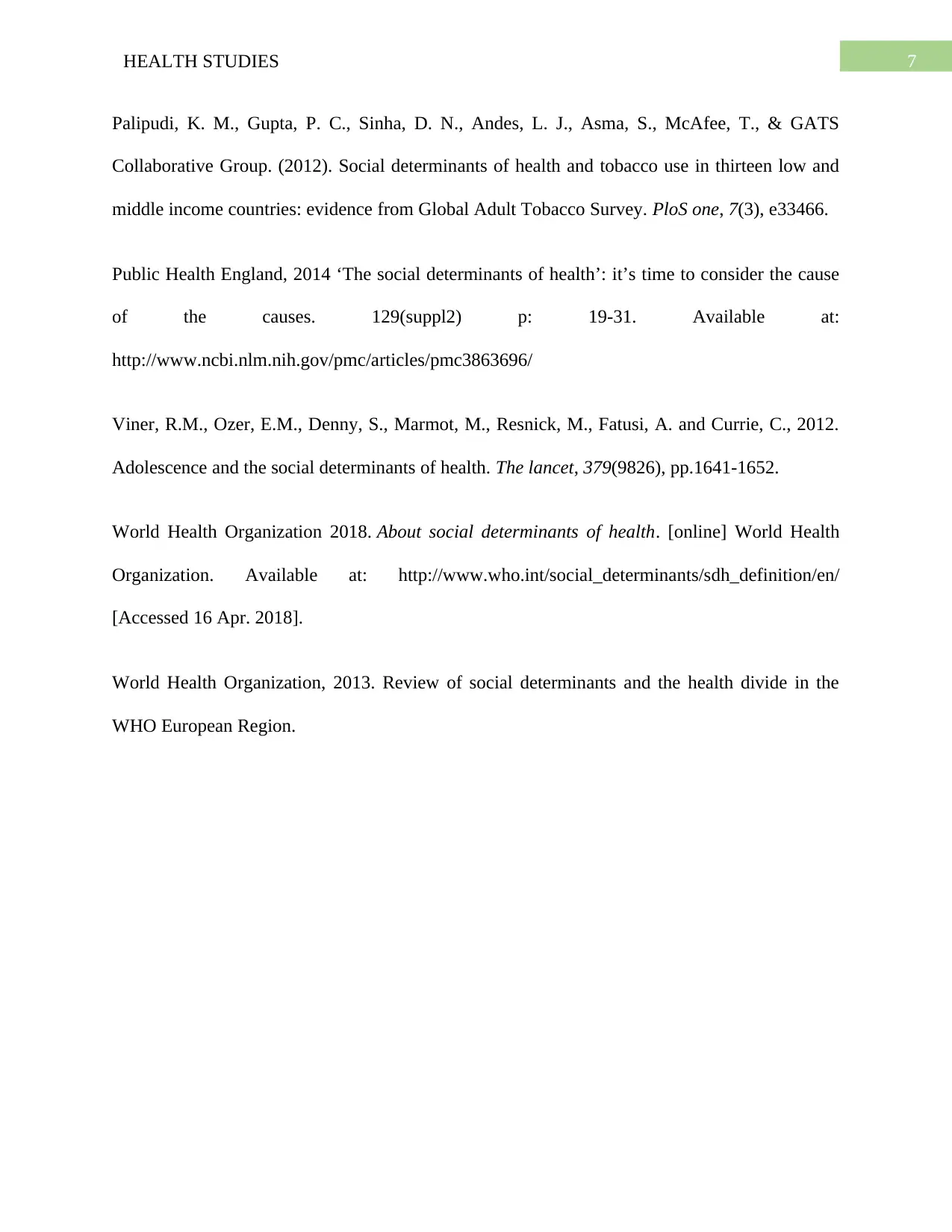
7HEALTH STUDIES
Palipudi, K. M., Gupta, P. C., Sinha, D. N., Andes, L. J., Asma, S., McAfee, T., & GATS
Collaborative Group. (2012). Social determinants of health and tobacco use in thirteen low and
middle income countries: evidence from Global Adult Tobacco Survey. PloS one, 7(3), e33466.
Public Health England, 2014 ‘The social determinants of health’: it’s time to consider the cause
of the causes. 129(suppl2) p: 19-31. Available at:
http://www.ncbi.nlm.nih.gov/pmc/articles/pmc3863696/
Viner, R.M., Ozer, E.M., Denny, S., Marmot, M., Resnick, M., Fatusi, A. and Currie, C., 2012.
Adolescence and the social determinants of health. The lancet, 379(9826), pp.1641-1652.
World Health Organization 2018. About social determinants of health. [online] World Health
Organization. Available at: http://www.who.int/social_determinants/sdh_definition/en/
[Accessed 16 Apr. 2018].
World Health Organization, 2013. Review of social determinants and the health divide in the
WHO European Region.
Palipudi, K. M., Gupta, P. C., Sinha, D. N., Andes, L. J., Asma, S., McAfee, T., & GATS
Collaborative Group. (2012). Social determinants of health and tobacco use in thirteen low and
middle income countries: evidence from Global Adult Tobacco Survey. PloS one, 7(3), e33466.
Public Health England, 2014 ‘The social determinants of health’: it’s time to consider the cause
of the causes. 129(suppl2) p: 19-31. Available at:
http://www.ncbi.nlm.nih.gov/pmc/articles/pmc3863696/
Viner, R.M., Ozer, E.M., Denny, S., Marmot, M., Resnick, M., Fatusi, A. and Currie, C., 2012.
Adolescence and the social determinants of health. The lancet, 379(9826), pp.1641-1652.
World Health Organization 2018. About social determinants of health. [online] World Health
Organization. Available at: http://www.who.int/social_determinants/sdh_definition/en/
[Accessed 16 Apr. 2018].
World Health Organization, 2013. Review of social determinants and the health divide in the
WHO European Region.
1 out of 8
Related Documents
Your All-in-One AI-Powered Toolkit for Academic Success.
+13062052269
info@desklib.com
Available 24*7 on WhatsApp / Email
![[object Object]](/_next/static/media/star-bottom.7253800d.svg)
Unlock your academic potential
Copyright © 2020–2025 A2Z Services. All Rights Reserved. Developed and managed by ZUCOL.



